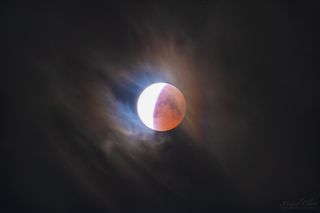Total Lunar Eclipse Gets a Cloudy Halo in Cool Time-Lapse Video
Miguel Claro is a professional photographer, author and science communicator based in Lisbon, Portugal, who creates spectacular images of the night sky. As a European Southern Observatory photo ambassador, a member of The World At Night and the official astrophotographer of the Dark Sky Alqueva Reserve, he specializes in astronomical skyscapes that connect Earth and the night sky. Join Miguel here as he takes us through his photograph "Visible Corona During the Partial Phase of the Total Lunar Eclipse."
On July 27, 2018, many places around the world could witness the longest total lunar eclipse of the century. As with any skywatching event, clouds are not so welcome during eclipses, because they can block the show. However, sometimes clouds can be a treat.
In this video of the "blood moon" eclipse, a thin layer of passing clouds with small ice crystals has helped to reveal a striking and even romantic view of a lunar corona glowing like a halo around the moon. This optical phenomenon is the result of the interaction between moonlight and our atmosphere. [Amazing Photos: The 'Blood Moon' Eclipse of July 2018]
According to physicist Les Cowley of the website Atmospheric Optics, lunar coronas "are seen when the clouds are thin enough that each single corona light ray reaching the eye is scattered or diffracted by only one droplet" of moisture in the atmosphere. "Of course, the whole corona is made by a great many droplets individually scattering the moonlight," Cowley wrote. "Any small particle can make a corona. Ice crystals in high clouds form them. Even wind-drifting pollen grains make them."

The image and time-lapse sequence of the partial ending phase of the total lunar eclipse on July 27 shows a few seconds of some iridescent clouds and a short lunar corona around the eclipsed disk of the moon. While the partial phase is moving forward, we can also see the intense light of the sun catching and hiding the well-known Tycho Crater. The image was captured in Campinho, Dark Sky Alqueva Reserve, Portugal.
Editor's note: If you captured an amazing astronomy photo and would like to share it with Space.com for a story or gallery, send images and comments to managing editor Tariq Malik at spacephotos@space.com.
To see more of Claro's amazing astrophotography, visit his website, www.miguelclaro.com. Follow us @Spacedotcom, Facebook and Google+. Original article on Space.com.
Get the Space.com Newsletter
Breaking space news, the latest updates on rocket launches, skywatching events and more!
Join our Space Forums to keep talking space on the latest missions, night sky and more! And if you have a news tip, correction or comment, let us know at: community@space.com.
